

Eye tracking. Eye tracking - Recherche Google - Mozilla Firefox. Eye tracking. Scientists track eye movements in glaucoma patients to check vision impairment while driving.
Yarbus eye tracker from the 1960s. History[edit] In the 1800s, studies of eye movement were made using direct observations. In 1879 in Paris, Louis Émile Javal observed that reading does not involve a smooth sweeping of the eyes along the text, as previously assumed, but a series of short stops (called fixations) and quick saccades.[1] This observation raised important questions about reading, questions which were explored during the 1900s: On which words do the eyes stop? For how long? An example of fixations and saccades over text. Edmund Huey[2] built an early eye tracker, using a sort of contact lens with a hole for the pupil.
The first non-intrusive eye-trackers were built by Guy Thomas Buswell in Chicago, using beams of light that were reflected on the eye and then recording them on film. In the 1950s, Alfred L. Tracker types[edit] Eye Tracking Device. Eye Tracking Device (ETD) The Eye Tracking Device (ETD) is a headmounted device, designed for measurement of three-dimensional eye and head movements under experimental and natural conditions.
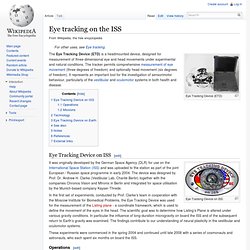
The tracker permits comprehensive measurement of eye movement (three degrees of freedom) and optionally head movement (six degrees of freedom). It represents an important tool for the investigation of sensorimotor behaviour, particularly of the vestibular and oculomotor systems in both health and disease. EyeTracking, Inc - Home. EyeTracking, Inc - Solutions - Consumer Marketing. The eye of the consumer holds a wealth of valuable information, and yet sometimes it doesn't tell the whole story.
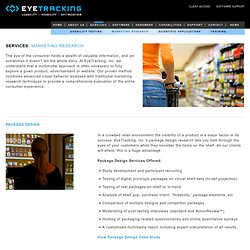
At EyeTracking, Inc. we understand that a multimodal approach is often necessary to fully explore a given product, advertisement or website. Our proven method combines advanced visual behavior analyses with traditional marketing research techniques to provide a comprehensive evaluation of the entire consumer experience. In a crowded retail environment the visibility of a product is a major factor in its success. EyeTracking, Inc.'s package design research lets you look through the eyes of your customers while they consider the items on the shelf. Package Design Services Offered: Study development and participant recruiting Testing of digital prototype packages on virtual shelf-sets (hi-def projection) Testing of real packages on-shelf or in-hand Analysis of shelf pop, purchase intent, ‘findability,’ package elements, etc. View Package Design Case Study.
Communiquez différemment. L’essentiel à savoir sur l’oculométrie (Eye Tracking - suivi du. Par Olivier Duffez, Mardi 12 février 2008.
Moteurs de recherche 2010. Suite et fin des trois billets consacrés à Gord Hotchkiss, après Search Engine Results 2010 et Les moteurs de recherche innovent, pourquoi les marketers Web n’en font-ils pas autant ? L'occasion m'en est donnée par la publication du deuxième volet (premier) de ses interviews sur « à quoi ressemblera une page de résultats dans trois ans ? ». Eye-tracking The Lab. Gestalt Principles and Dynamic Symmetry. © 2002. all rights reserved. 'Graphic designers give visual form to ideas through formmaking.
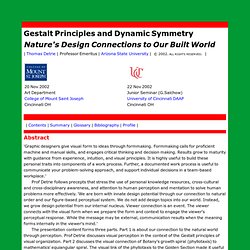
Formmaking calls for proficient machine and manual skills, and engages critical thinking and decision making. Results grow to maturity with guidance from experience, intuition, and visual principles. It is highly useful to build these personal traits into components of a work process. Further, a documented work process is useful to communicate your problem-solving approach, and support individual decisions in a team-based workplace.' Prof Detrie follows precepts that stress the use of personal knowledge resources, cross-cultural and cross-disciplinary awareness, and attention to human perception and mentation to solve human problems more effectively.
The presentation content forms three parts. Introduction My presentation discusses some natural principles important to visual design. Graphic designers give the visual form to ideas through formmaking. Blog Archive » “La plupart des gens n’a. De nombreux consultants font le constat sur base d’analyses “bottom line” que le métier de la Usability est instable par manque de savoirs fondamentaux et de méthodes.

Un post de Bruce Temkin (Forrester) met en avant le manque de rigueur des processus et des définitions : “One of the key problems with customer experience is that it’s not an “official” discipline like engineering and accounting. So it lacks a lot of rigor around processes and definitions.” Bruce Temkin – 2008 Un post de Jakob Nielsen met en avant le manque de connaissances en sciences comportementales et en méthodologie : “Many people without a grounding in behavioral user-research principles use bogus methodology and thus get misleading findings.” – Jakob Nielsen (2007) Fundamental Knowledge. Blog Archive » Mislead visual behaviour. Blog Archive » What is peripheral visio. Eyetracking material allows you to see what users have looked at, but not necessarily what they have seen.This week, we will answer the following question: “How does the brain choose to guide the eye from one place to the other?”
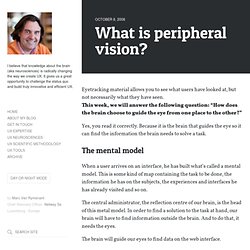
Yes, you read it correctly. Because it is the brain that guides the eye so it can find the information the brain needs to solve a task. The mental model When a user arrives on an interface, he has built what’s called a mental model. This is some kind of map containing the task to be done, the information he has on the subjects, the experiences and interfaces he has already visited and so on.
The central administrator, the reflection centre of our brain, is the head of this metal model. The brain will guide our eyes to find data on the web interface. The foveal vision The eye consists of cones and sticks. At 50 cm away from the screen, which is the average distance measured in physiological ergonomics, the net zone we can see is a circle of circa 2,5 cm. Blog Archive » Guide the user’s look.
It is possible to invite the visual system of a user to follow a pre-determined visual path on the screen.
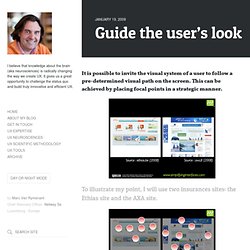
This can be achieved by placing focal points in a strategic manner. To illustrate my point, I will use two insurances sites: the Ethias site and the AXA site. Focal points are the places our eyes will visit, as commanded by the brain, in order to find information. The visual pathway is the sum of the focal points our eyes have visited. It allows our eyes to go from one focal point to the other. An expert can draw a visual path within a screen that 80% of users will follow in order to perform an identical task. The placement of focal points is thus a strategic issue. [Relayage] un simulateur d'eye-tracking en ligne - Alsacréations. Trouvé sur le blog de Sébastien Billard, lui-même via le blog d'Eliaz, le site Feng-gui.com propose un outil en ligne gratuit d'Eye-Tracking (oculométrie), c'est à dire une analyse des mouvements des yeux sur une page web.
![[Relayage] un simulateur d'eye-tracking en ligne - Alsacréations](http://cdn.pearltrees.com/s/pic/th/simulateur-alsacreations-111343)
Même s'il n'y a rien de révolutionnaire (on se doute un peu du résultat obtenu en général), l'outil est assez plaisant, simple à l'usage et assez pratique pour certains besoins (qui a dit où vais-je mettre mes pubs Adsense ?). On se demande même où se trouvent tous les petits chinois qui travaillent en direct sur le site pour tester et afficher les résultats. En fait l'explication est simple, comme le dit Sébastien : Il ne s'agit pas de réel tests utilisateurs, mais d'une modélisation du comportement de ceux-ci, basées sur des études en neurosciences portant sur l'attention, la perception et la cognition.
Bah, pas grave, l'outil est très bien quand-même :) Feng-GUI - Feng Shui for Graphic User Interfaces. Interview avec Rafael Mizrahi (Feng-GUI) - Référencement, Design. La présentation de ViewFinder il y a 2 jours avait soulevé quelques commentaires et interrogations. Rafael Mizrahi, directeur de la technologie chez Feng-GUI et créateur de l'algorithme a gentiment accepté de répondre à mes questions. Sébastien Billard : Bonjour Rafael, pourriez-vous vous présenter aux lecteurs ? Rafael Mizrahi : Je travaille dans l'industrie informatique depuis plus de 16 ans. Un simulateur d'eye-tracking pour tester ses interfaces - Référe. Le Eyetracking: que voient vos visiteurs? Une surprise attend ceux qui lisent l’article jusqu’à la fin..
Le Eyetracking permet de savoir exactement où les visiteurs d’un site regardent lorsqu’ils arrivent sur une page. La méthode est à première vue aussi efficace que le nouveau Google Website Optimizer mais elle n’est pas disponible pour tout le monde. Elle pourrait le devenir avec une souris guidée par l’oeil mais ce n’est pas encore pour demain. En 2005, Nielsen a mené une recherche sur 255 personnes à New York.
Chaque sujet devait compléter 50 tâches précises en 1 à 2 heures. Dans les scénarios proposés, les sujets devaient lire les News simplement ou les lire en les retenant. Utilisabilité.info - le portail de l'utilisabilité. Utilisabilité.info - Les Nouvelles de l'Utilisabilité. Ergonomic Garden - sqli agency - Ergonomie Web - 5 mythes sur l’ MIRATECH : les études eye tracking. Qu’est ce que l’eye tracking ? L’eye tracking, ou oculométrie, est la mesure du mouvement des yeux.
Miratech applique cette technologie aux tests utilisateurs sur les interfaces digitales (sites web, applis mobiles) et aux études consommateurs sur les interfaces offline (publicité, affichage, packaging…) Dans notre laboratoire, nous organisons des séances de tests individuels sur un panel de participants pour déterminer où se pose leur regard sur l’interface. Grâce à l’eye tracking, nous mesurons les zones qui sont vues, lues, utilisées ou ignorées. MIRATECH : ergonomie web, tests utilisateurs, eye tracking. Www.pertech.fr. Eyetracking Research into Web Usability. November 1, 2010 Users pay close attention to photos and other images that contain relevant information but ignore fluffy pictures used to 'jazz up' Web pages. August 9, 2010 Showing summaries of many articles is more likely to draw in users than providing full articles, which can quickly exhaust reader interest.
June 21, 2010 Slow page rendering today is typically caused by server delays or overly fancy page widgets, not by big images. April 6, 2010 Web users spend 69% of their time viewing the left half of the page and 30% viewing the right half. March 22, 2010 Web users spend 80% of their time looking at information above the page fold. May 25, 2009 Individual investors are intimidated by overly complex IR sites and need simple summaries of financial data. » Eye-Tracking : l’importance des liens sponsorisés sur Google - Eye-Tracking : l’importance des liens sponsorisés sur Google Trouvé le 27 mars 2009 à 7:52 par s2m - 814 vues.
Démo d'eye tracking. Eye tracking, conception de eye tracker et tests utili. Eye tracking, conception de eye tra.